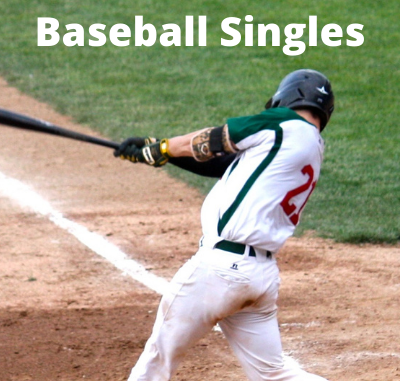
A single in baseball is when a batter hits the ball and successfully reaches first base (and only first base) without a fielder making an error or attempting to put out another runner. A batter may be credited with a single if they reach second base, third base, or home plate; and an error occurred on the play and the official scorer determines that the batter would have only reached second base if the error had not occurred.
Common Questions
What is the difference between a single and a fielder’s choice?
A fielder’s choice means the defensive player successfully put out a player other than the hitter. Even though the hitter successfully reaches first base, they do not receive credit for a single. An example: the batter hits the ball to the shortstop who throws the baseball to the secondbaseman before the runner from first reaches the bag; the secondbaseman then throws to first but the hitter reaches bases before the throw arrives. In this case, the runner who was on first before the ball was hit is out, and the hitter is safe.
Video example:
What is the difference between a single and a walk?
Both involve a hitter advancing a single base. A single, though, involves the batter hitting the ball and advancing safely to first. Singles provide runners on base the opportunity to advance more than one base (e.g., first base to third base; or second base to home).
Walks only allow the hitter to advance one base, and then any subsequent runners forced to also advance (e.g., a runner on first would advance to second). For this reason, singles project to add more runs than walks (0.7 runs vs. 0.55 runs according to this Fangraphs article).
Does a batter get credit for a hit if they are thrown out going to 2nd base?
Yes, a batter still gets credit for a hit even if they are thrown out attempting to reach second base for a double. In this case, they are credited with a single.
Lots of Data about Singles
Career Leaders in Singles
| Player Name | # of Singles | # of Plate Apperances |
|---|---|---|
| Pete Rose | 3,215 | 15,876 |
| Ty Cobb | 3,053 | 13,072 |
| Eddie Collins | 2,643 | 12,037 |
| Cap Anson | 2,598 | 11,319 |
| Derek Jeter | 2,595 | 12,602 |
| Ichiro Suzuki | 2,514 | 10,734 |
| Willie Keeler | 2,513 | 9,594 |
| Honus Wagner | 2,422 | 11,739 |
| Rod Carew | 2,404 | 10,550 |
| Tris Speaker | 2,383 | 11,988 |
Slapstick Players (Players with Highest Percentage of Singles)
This table shows the players with the highest percentage of their career hits being singles. I limited the list to only those hitters with at least 1,000 career hits.
| Player Name | # of Career Singles | # of Career Hits | Percentage |
|---|---|---|---|
| Roy Thomas | 1,377 | 1,537 | 90% |
| Al Bridwell | 935 | 1,064 | 88% |
| Maury Wills | 1,866 | 2,134 | 87% |
| Otis Nixon | 1,199 | 1,379 | 87% |
| Patsy Donovan | 1,955 | 2,253 | 87% |
| Sandy Alomar | 1,010 | 1,168 | 86% |
| Jimmy Slagle | 1,158 | 1,340 | 86% |
| Miller Huggins | 1,269 | 1,474 | 86% |
| Willie Keeler | 2,513 | 2,932 | 86% |
| Davy Jones | 873 | 1,020 | 86% |
Power Players (Players With Lowest Percentage of Singles)
This table shows the players with the lowest percentage of their career hits being singles. I limited the list to only those hitters with at least 1,000 career hits.
| Player Name | # of Career Singles | # of Career Hits | Percentage |
|---|---|---|---|
| Mark McGwire | 1,626 | 785 | 48% |
| Adam Dunn | 1,631 | 825 | 51% |
| Barry Bonds | 2,935 | 1,495 | 51% |
| Giancarlo Stanton | 1,160 | 591 | 51% |
| David Ortiz | 2,472 | 1,280 | 52% |
| Hank Greenberg | 1,628 | 847 | 52% |
| Carlos Delgado | 2,038 | 1,064 | 52% |
| Carlos Pena | 1,146 | 603 | 53% |
| Babe Ruth | 2,873 | 1,517 | 53% |
| Gorman Thomas | 1,051 | 558 | 53% |

